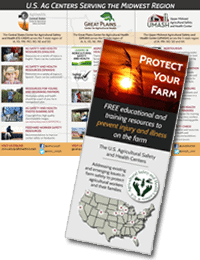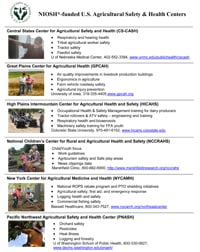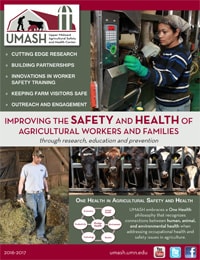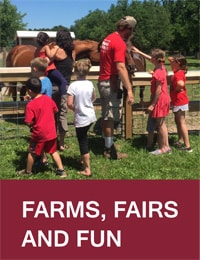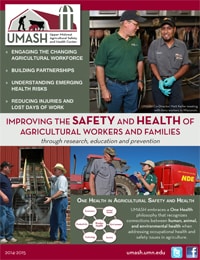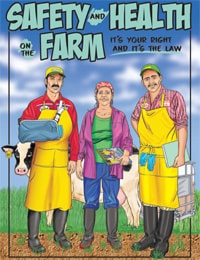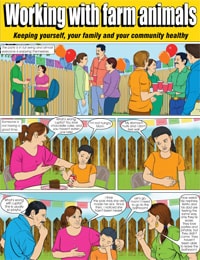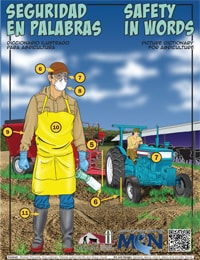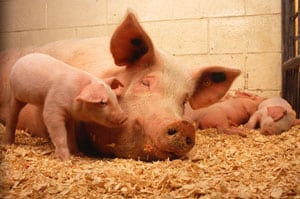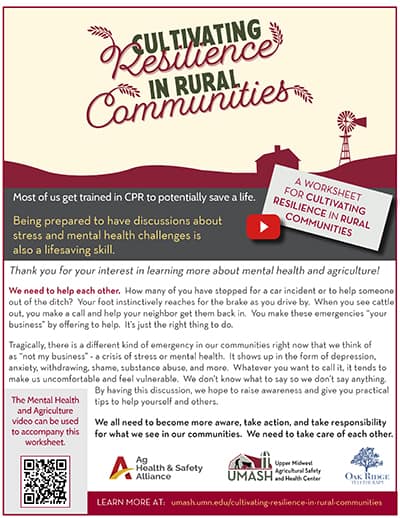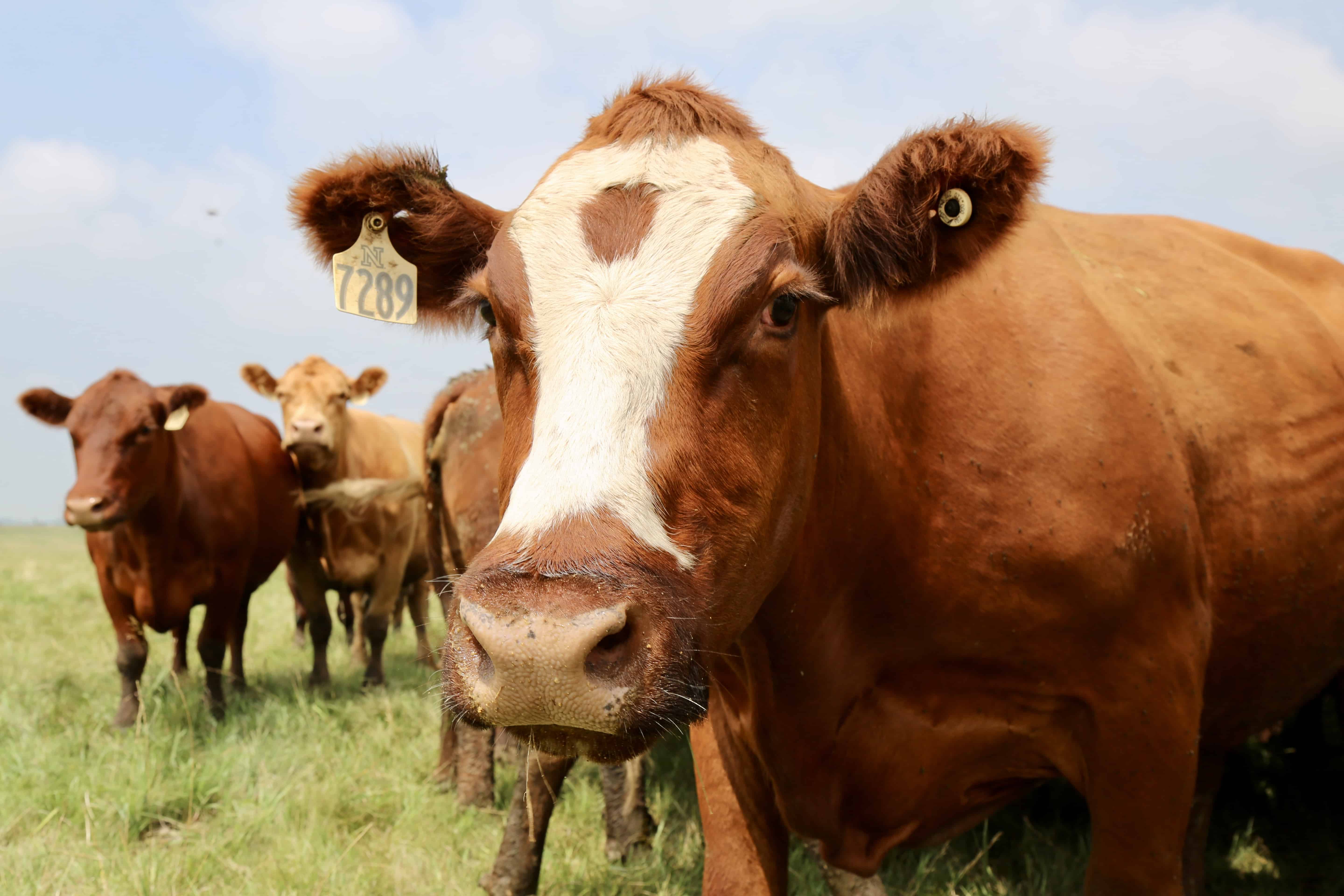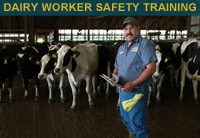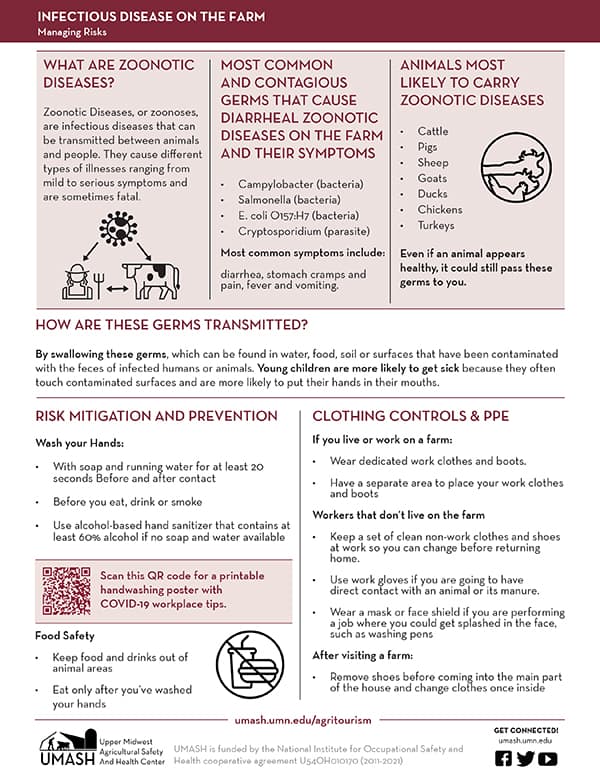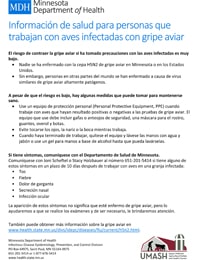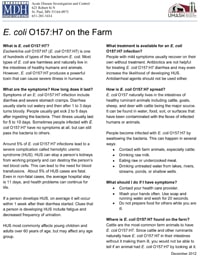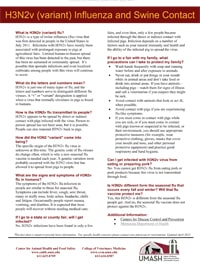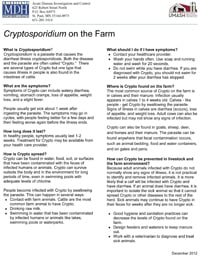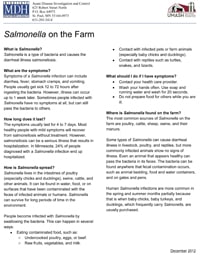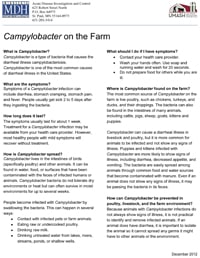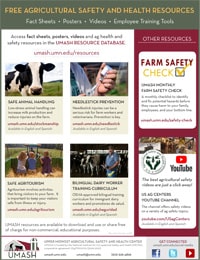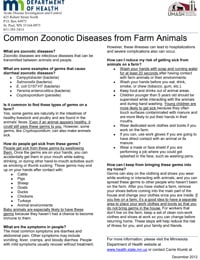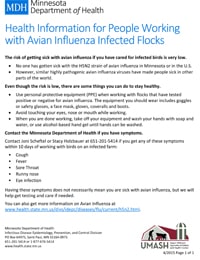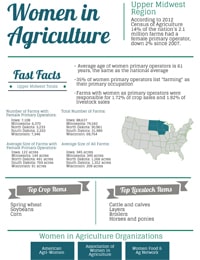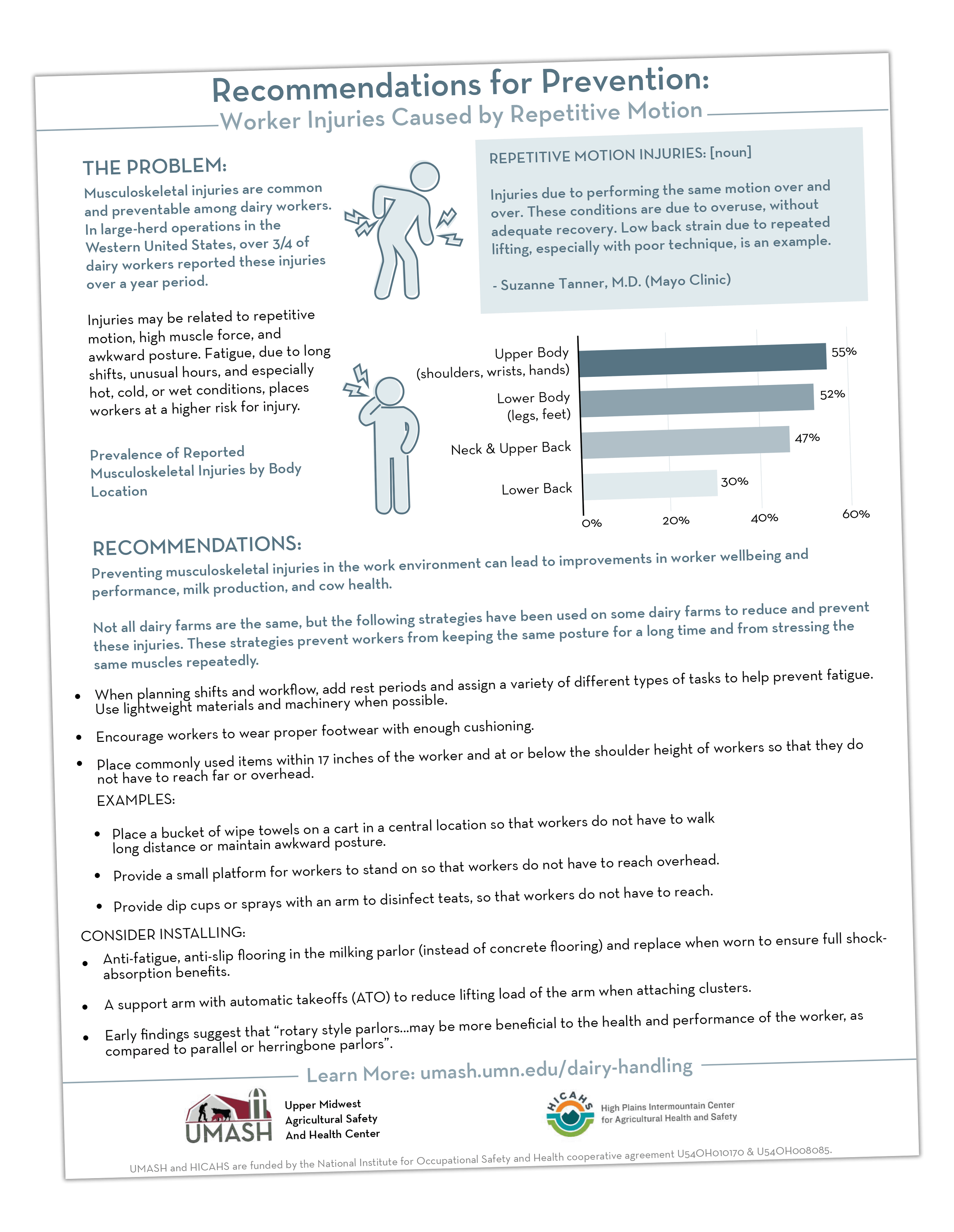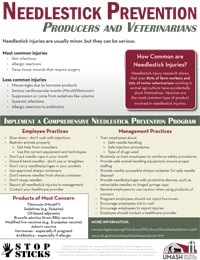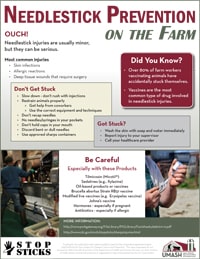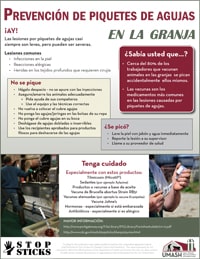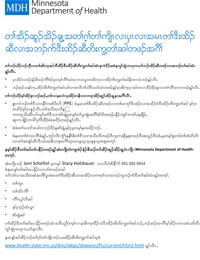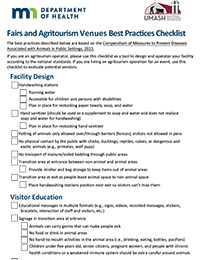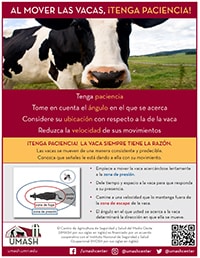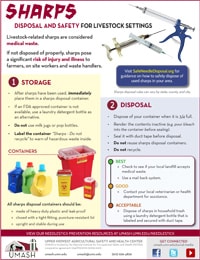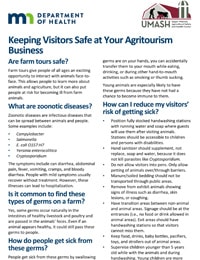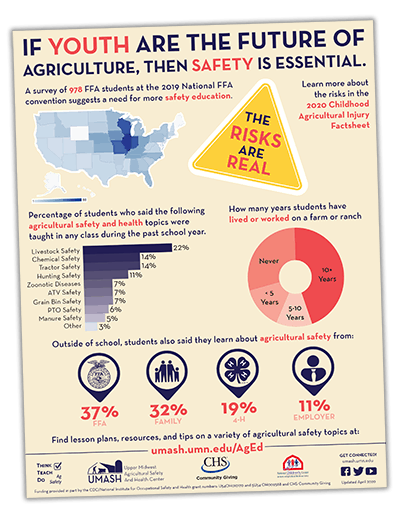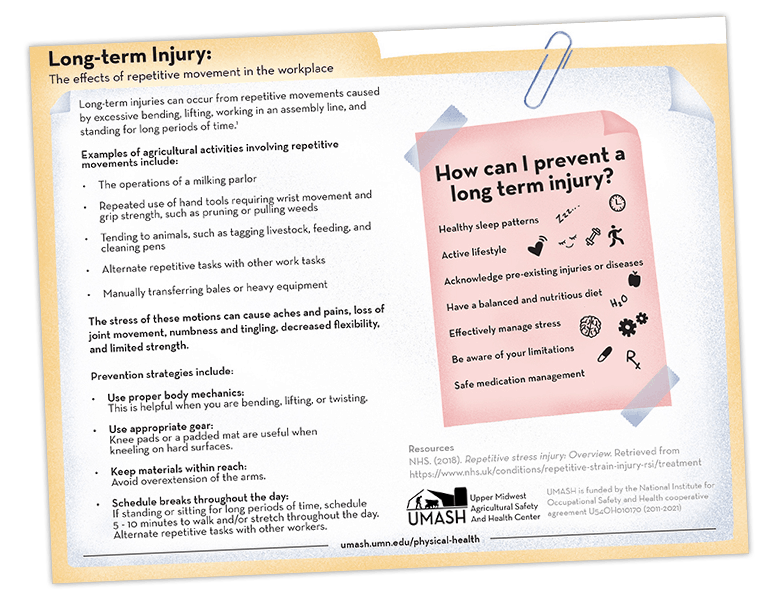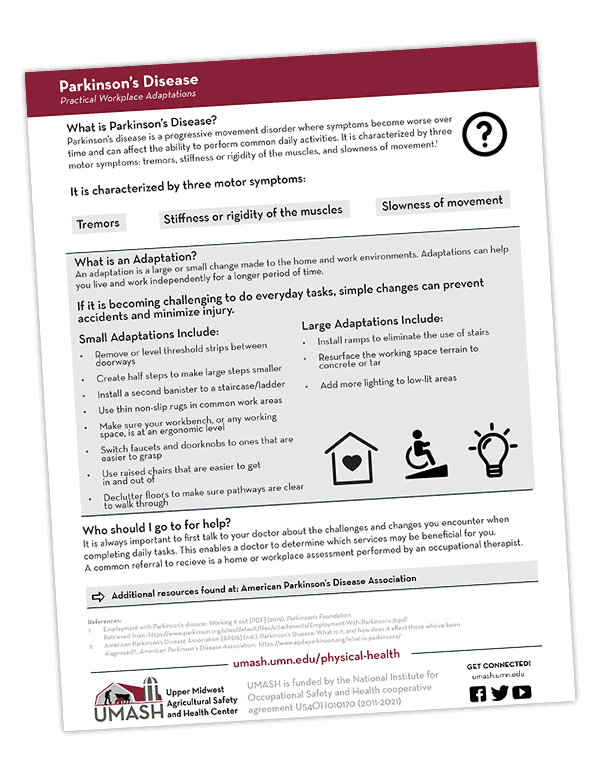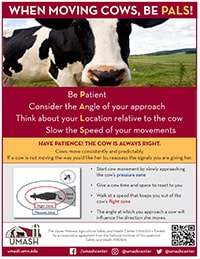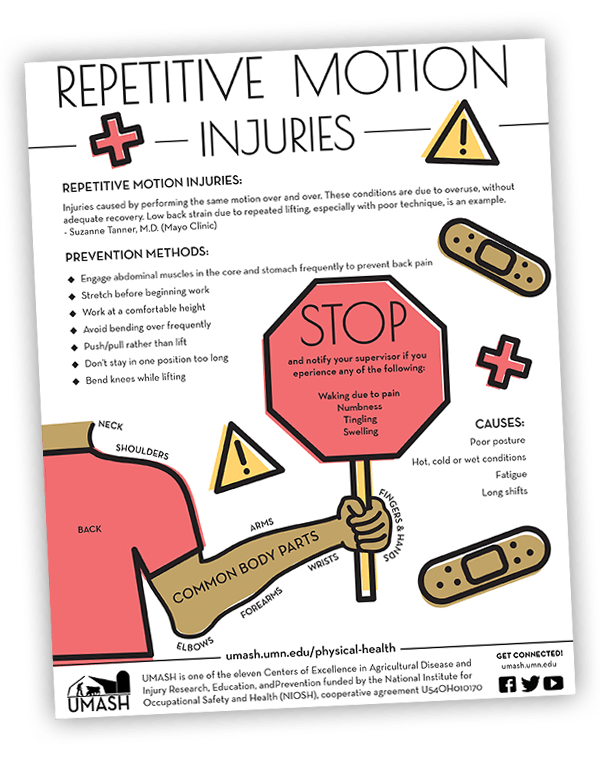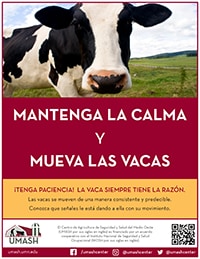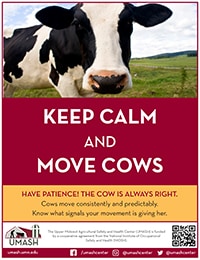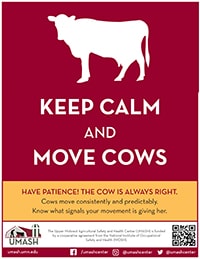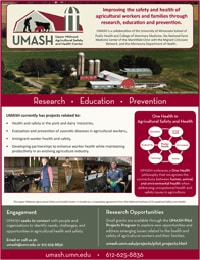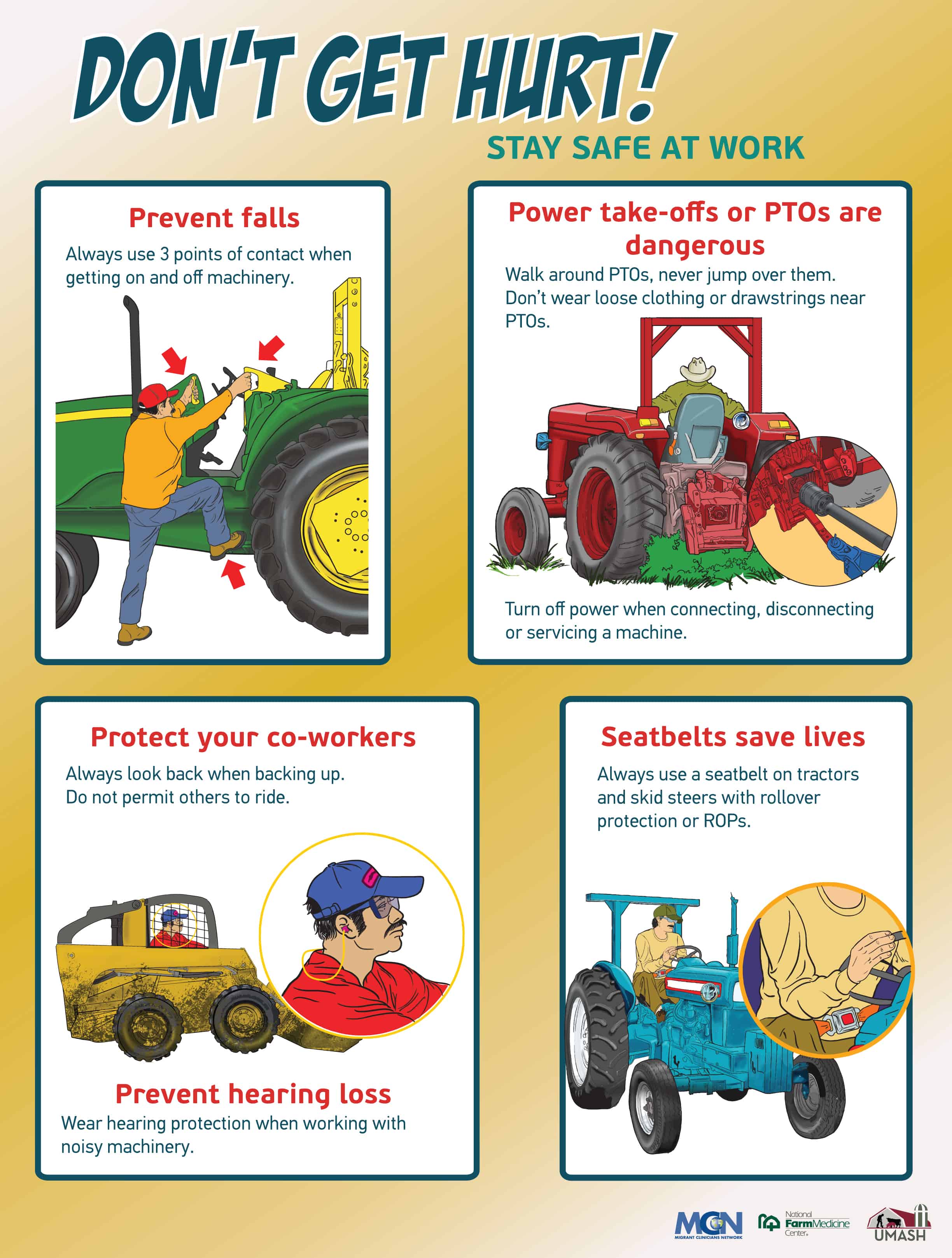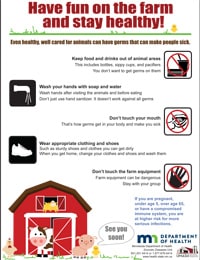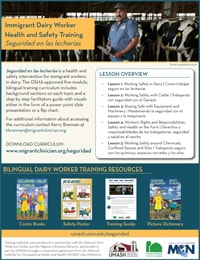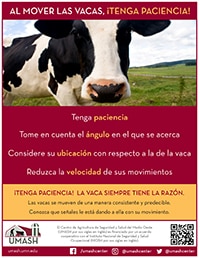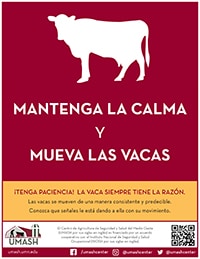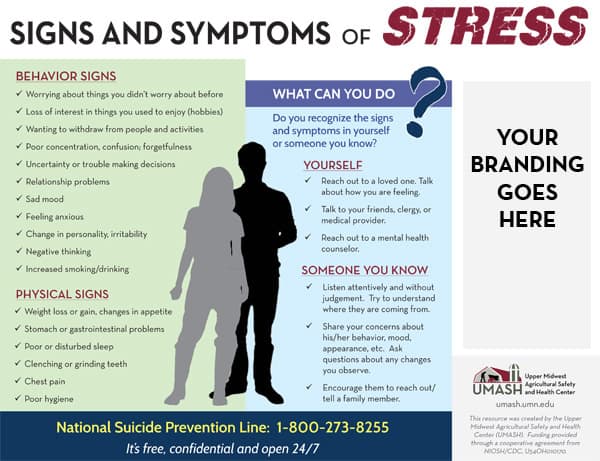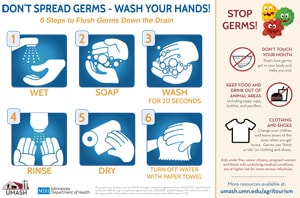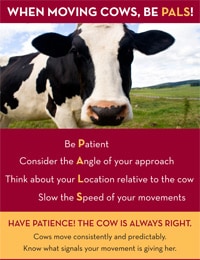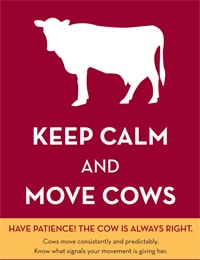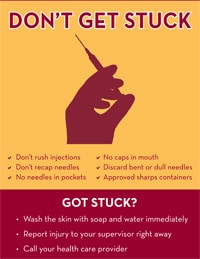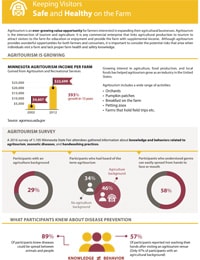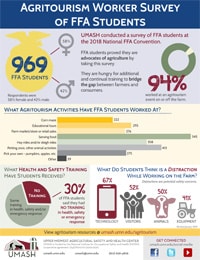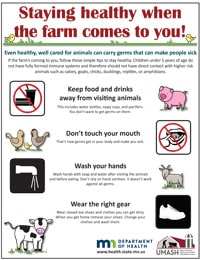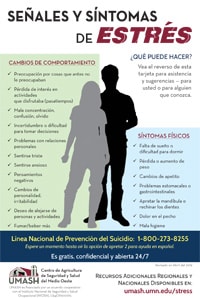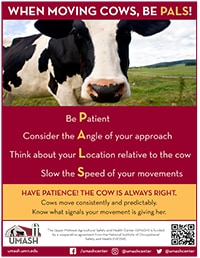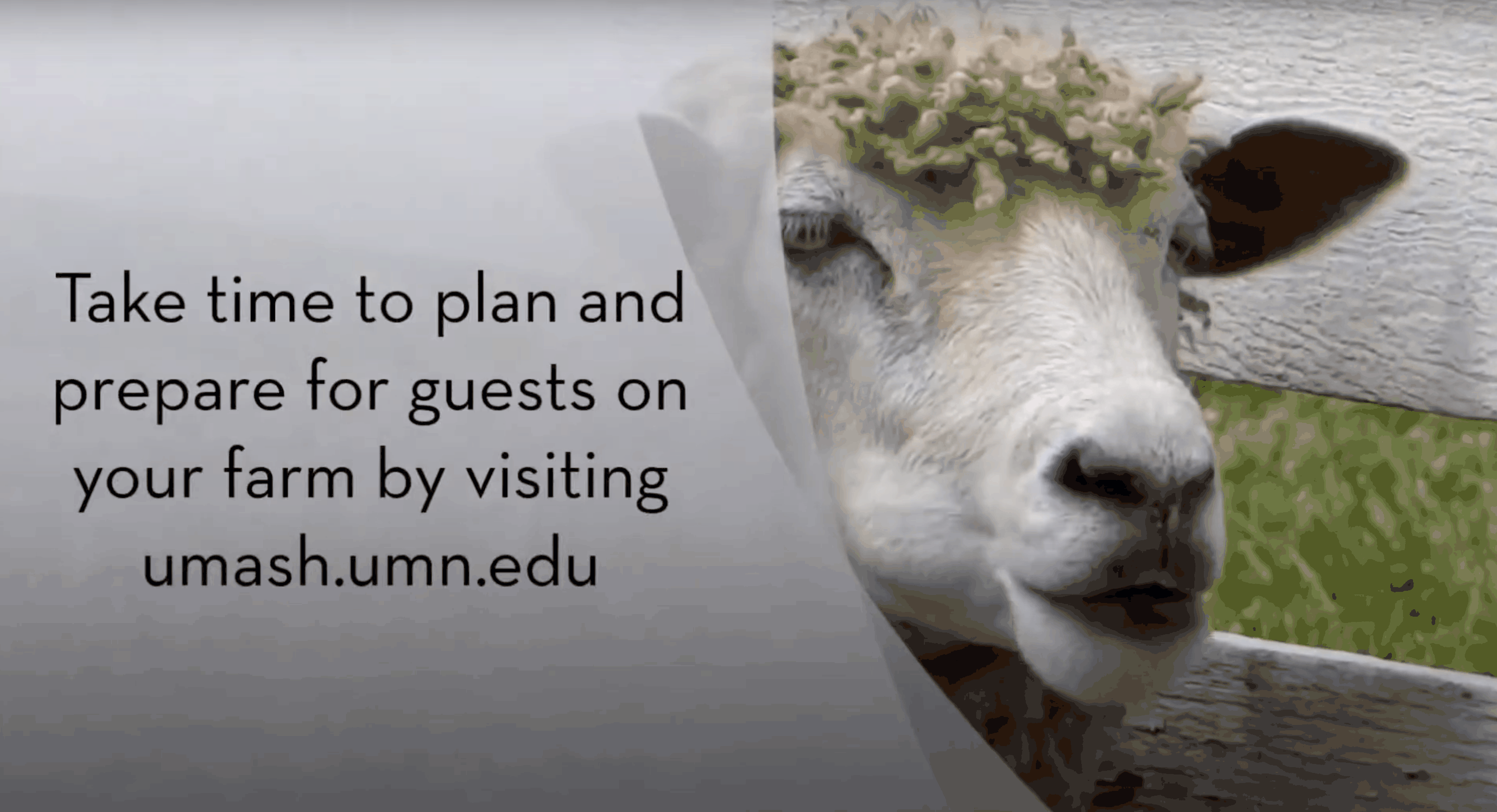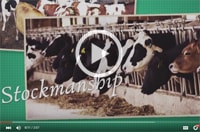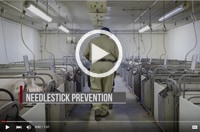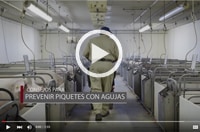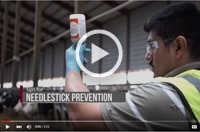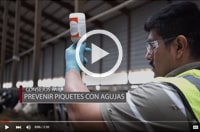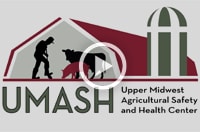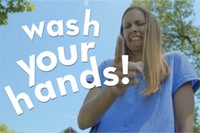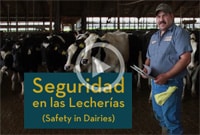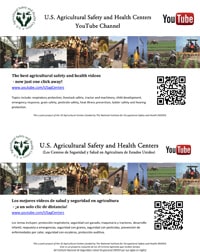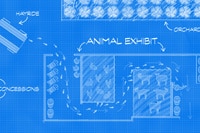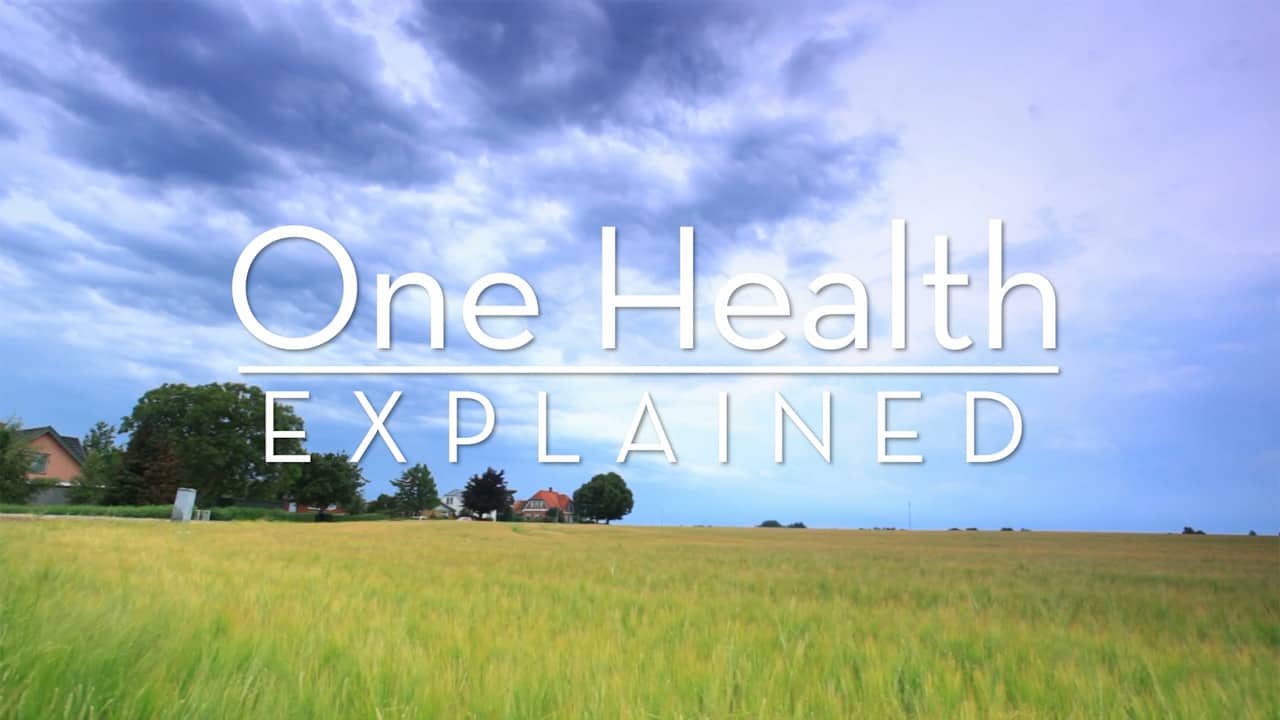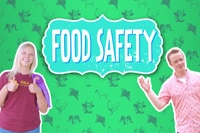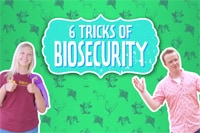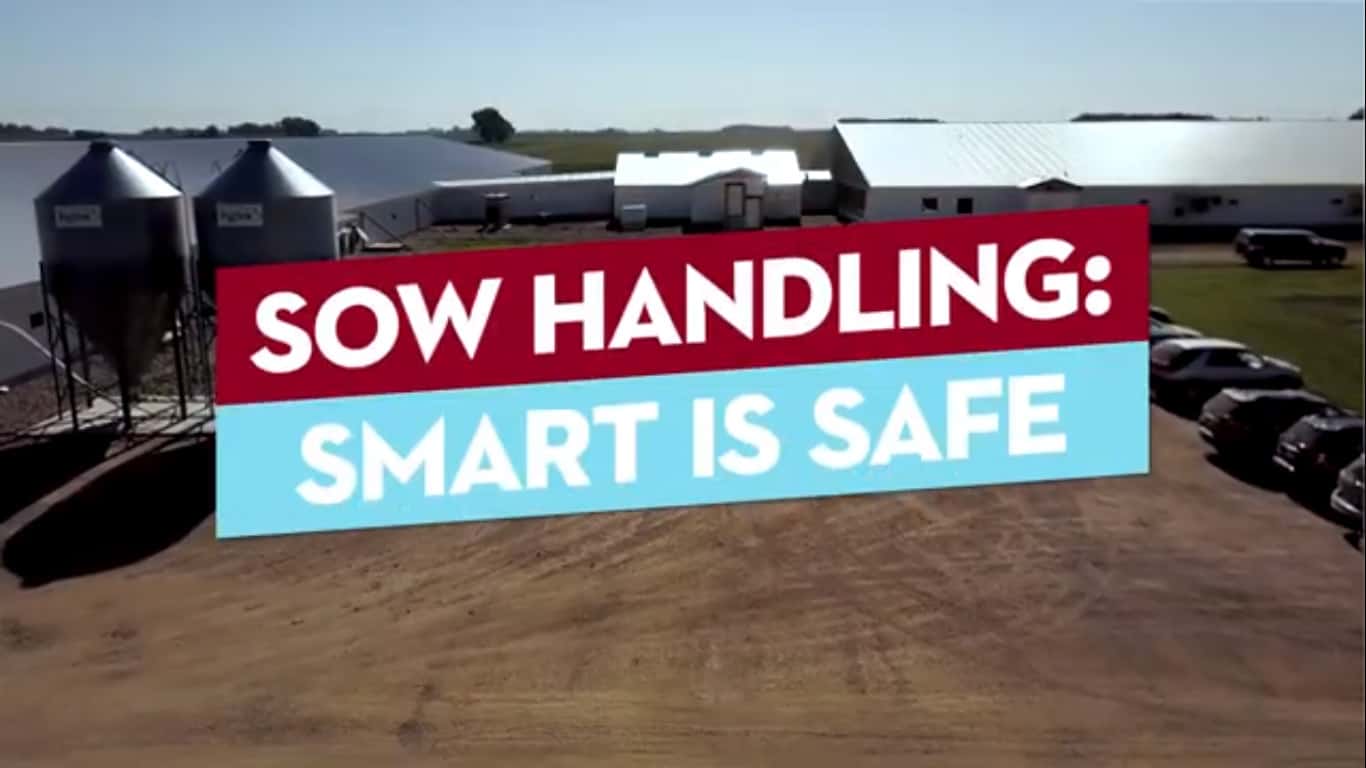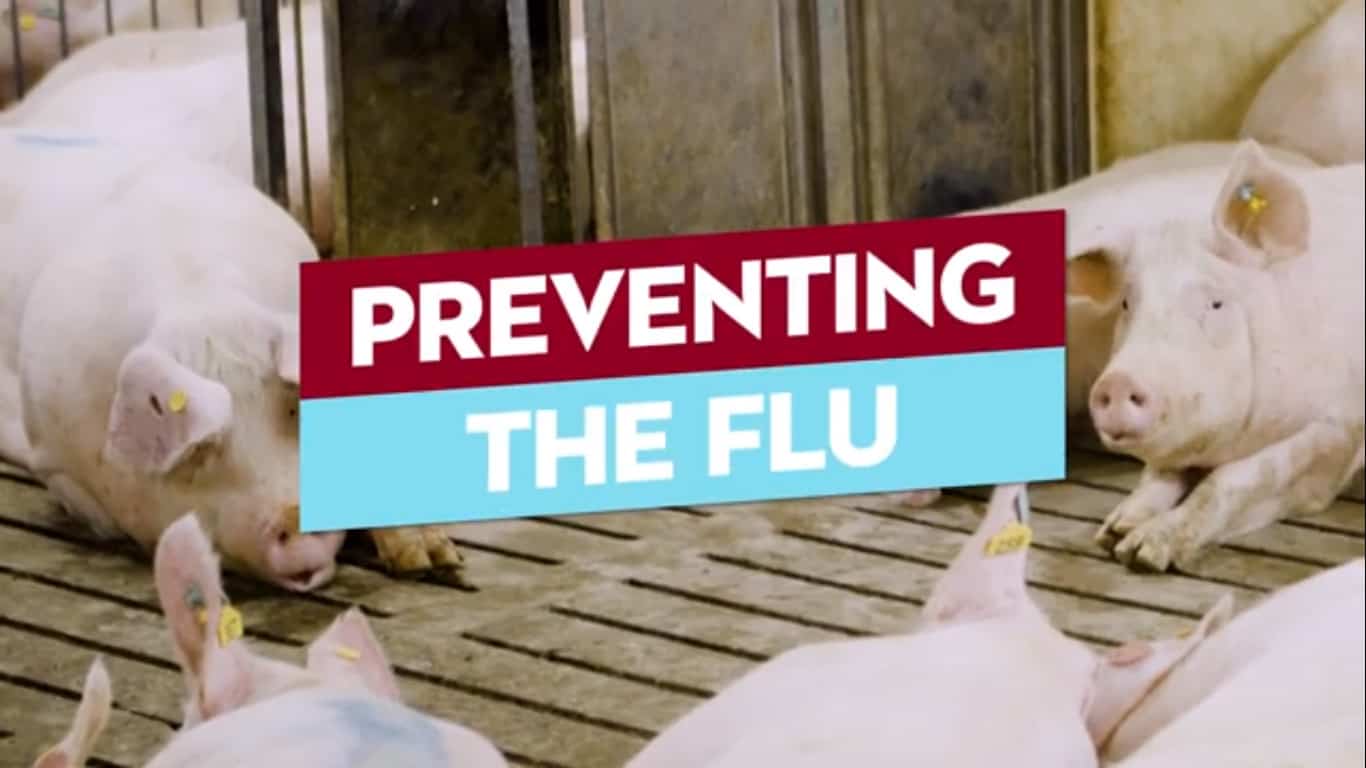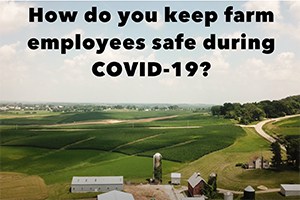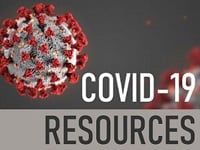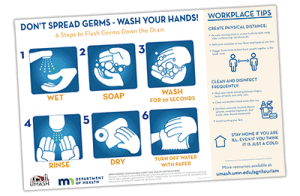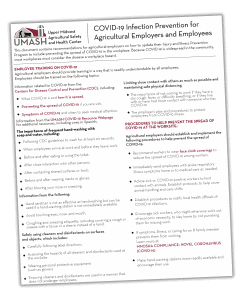Know how to recognize the signs and symptoms of stress and what you can do for yourself and others.
This resource was created to address the emerging issue of stress and mental health challenges facing farmers, agricultural workers, and their families. The card lists some of the behavioral and physical signs of stress, as well as tips and resources for what to do if you or someone you know is experiencing stress or mental health challenges. OPEN PDFThis is a printable PDF of the websites and social media links for the U.S. Agricultural Safety and Health Centers.
This is a printable PDF of the NIOSH U.S. Agricultural Safety and Health Centers with their contact information and topics of interest.
The 2016-2017 UMASH highlights flier spotlights some of the recent research and outreach activities of UMASH.
It’s fun to get out on a working farm to experience farm life; spend time outside and find out where your food comes from. But contact with animals is always a potential risk for getting sick. Out on the farm washing your hands is really important. Farm visitors haven’t built up an immunity to farm germs so they are more vulnerable, especially kids under 5, senior citizens, pregnant women, and anyone with an underlying medical condition. Illnesses like E. coli and Salmonella are among the illnesses you can get from being on a farm.
Handwashing with soap and water is a simple way to reduce your risk. Following six simple steps in this brochure will help remove germs that may have accumulated on your hands during a farm visit. Washing with soap and water is better than using hand sanitizer. Sanitizer does not work against all germs and won’t work if your hands are visibly dirty.
Even healthy animals have germs that can make you sick. Be sure to wash your hands after visiting an animal area and before doing anything else. Always wash your hands before eating.
UMASH, in partnership with the Minnesota Department of Health, has developed this brochure as a companion to a hand-washing video, along with a variety of other resources to help farmers and agritourism operators keep their visitors safe.
For more information and resources on agritourism visit: umash.umn.edu/agritourism
The 2014-2015 UMASH highlights flier spotlights some of the recent research and outreach activities of UMASH.
A bilingual, full-color comic book about workers’ compensation and workers’ rights for immigrant dairy workers. It tells the story of a Mexican dairy worker injured on the job and the steps he and his employer take to ensure he receives benefits and the farm improves safety.
Available in English and Spanish, and versions for Minnesota, Wisconsin, New Mexico, and New York.
A bilingual, full color picture dictionary that illustrates work place hazards and best practices for health and safety in agriculture. Developed with support from the OSHA Susan Harwood Grant Program, this resource will bolster Hispanic workers’ English vocabulary and will help prevent agricultural injuries.
The Upper Midwest is home to swine production. From farrow to finish, producers need to be aware of the risks associated with hog farming and take precautions to avoid illness and injury.
UMASH has developed two videos and teaching guides for producers to focus on safety in their operation.
These guides are intended for training by farmers, ranchers, farm employees, veterinarians, human resources training staff and those involved with worker health and safety training/education.
The videos and accompanying guides address sow handling and swine influenza. Both are available in English and Spanish. The materials can be used in small groups or individually. There is a short quiz at the end of each video to check your understanding. After completing the two videos and related quizzes, a certificate of completion is available for printing.
Part 1: Swine Flu Prevention
Part 2: Sow Handling
The toolkit includes a discussion guide, participant worksheet, video and other materials that discussion leaders can use to plan, prepare and host a group conversation on mental health in agriculture in a community setting. The resources include the “nuts and bolts” of organizing, promoting and hosting a conversational event.
DOWNLOAD TOOLKITAgriculture can be a dangerous job. Safety and health can be overwhelming with the number of hazards on the farm. Too often we hear or read of farm incidents where a farm worker or family member was seriously injured or killed. At UMASH, we believe these injuries are preventable.
The UMASH Farm Safety Check is a quick review to identify and fix potential hazards before they cause harm to your family and employees – and your bottom line. Farm Safety Check will focus on a different topic, offering checklists and tips to help identify hazards, along with resources to remedy any problems.
Blank Safety Checklist
In addition to the topic-specific checklists, you can use this blank fillable PDF to list other safety hazards.
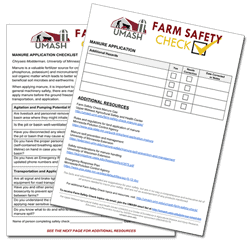
EXAMPLE TOPICS:
GRAIN HANDLING
CHEMICAL STORAGE
SAFE PLAY AREAS
ELECTRICAL SAFETY
ATV SAFETY
MANURE GAS
SILAGE STORAGE
…AND MORE
Working with large animals can be challenging for farmers and workers…
UMASH has developed training guides to accompany the 5-part video series on Dairy Stockmanship.
These guides are intended for training by farmers, ranchers, farm employees, veterinarians, human resources training staff and those involved with worker health and safety training/education.
The guides can be a tool for training and retraining workers. The materials can be used in small groups or individually. There is a short quiz at the end of each video to check your understanding. After completing the five videos and related quizzes, a certificate of completion is available for printing.
Part 1: Using Predictable Animal Behavior to Increase Milk Production
Part 2: How a Cow Uses Her Senses
Part 3: Working with the Pressure Zone
Part 4: Moving Cows More Effectively
Part 5: Making the Milking Parlor a Happy Place
Seguridad en las lecherías is a health and safety intervention for immigrant workers in dairy. This award winning project uses a popular education model that includes worker training and promotores de salud (or Community Health Workers) to reduce worksite hazards and to improve worker knowledge and practices. Through extensive input from workers, health and safety professionals and researchers, this project developed an OSHA-approved five-module, bilingual health and safety training curriculum. The curriculum includes background sections on each topic and a step by step facilitators guide with visuals either in the form a power point slide presentation or a flip chart.
LESSON OVERVIEW
Lesson 1: Working Safely in Dairy | Como trabajar seguro en las lecherías
Lesson 2: Working Safely with Cattle | Trabajando con seguridad con el Ganado
Lesson 3: Staying Safe with Equipment and Machinery | Manteniendo la seguridad con el equipo y la maquinaria
Lesson 4: Workers’ Rights and Responsibilities: Safety and Health on the Farm | Derechos y responsabilidades de los trabajadores: seguridad y salud en el rancho
Lesson 5: Working Safely around Chemicals, Confined Spaces and Silos | Trabajando seguro con los químicos, espacios cerrados y los silos
You may download each module to view its content or request power point versions or flip charts by visiting www.migrantclinician.org/seguridad. For additional information about accessing the curriculum contact Amy K. Liebman at aliebman@migrantclinician.org.
Zoonotic Diseases, or zoonoses, are infectious diseases that can be transmitted between animals and people. They cause different types of illnesses ranging from mild to serious symptoms and are sometimes fatal.
El riesgo de contraer la gripe aviar si ha tomado precauciones con las aves infectadas es muy bajo. A pesar de que el riesgo es bajo, hay algunas medidas que puede tomar para mantenerse sano.
E. coli O157:H7 fact sheet developed by the Minnesota Department of Health.
– What is E. coli O157:H7?
– What are the symptoms? How long does it last?
– What treatment is available for an E. coli O157:H7 infection?
– How is E. coli O157:H7 spread?
– Where is E. coli O157:H7 found on the farm?
– How can E. coli O157:H7 be prevented in livestock and the farm environment?
– How can I prevent the spread of E. coli O157:H7 and other germs from animals to humans?
– How can I prevent the spread of E. coli O157:H7 and other germs in my home?
Rabies fact sheet developed by the Minnesota Department of Health.
– What is rabies?
– Which animals carry rabies in Minnesota?
– What should I do if one of my animals is bitten by a skunk or other wild animal?
– What should I do if someone is bitten by a wild or domestic animal?
– The special case of bats
– How can rabies be prevented?
H3N2v (variant) Influenza and Swine Contact fact sheet developed by UMASH and the Center for Animal Health and Food Safety (CAHFS) at the University of Minnesota.
– What is H3N2v (variant) flu?
– How is the H3N2v flu transmitted to people?
– What precautions can I take to protect my family?
– What are the signs and symptoms of H3N2v flu in humans?
– Can I get infected with H3N2v virus from eating or preparing pork?
– Is H3N2v different from the seasonal flu that occurs every fall and winter? Will that flu vaccine protect me?
Cryptosporidium fact sheet developed by the Minnesota Department of Health.
– What is Cryptosporidium?
– What are the symptoms?
– How is Crypto spread?
– What should I do if I have symptoms?
– Where is Crypto found on the farm?
– How can Crypto be prevented in livestock and the farm environment?
– How can I prevent the spread of Crypto and other germs from animals to humans ?
Salmonella fact sheet developed by the Minnesota Department of Health.
– What is Salmonella?
– What are the symptoms?
– How long does it last?
– How is Salmonella spread?
– What should I do if I have symptoms?
– Where is Salmonella found on the farm?
– How can Salmonella be prevented in livestock, poultry, and the farm environment?
– How can I prevent the spread of Salmonella and other germs from animals to humans?
– How can I prevent the spread of Salmonella in my home?
Campylobacter fact sheet developed by the Minnesota Department of Health.
– What is Campylobacter?
– What are the symptoms?
– How long does it last?
– How is Campylobacter spread?
– What should I do if I have symptoms?
– Where is Campylobacter found on the farm?
– How can Campylobacter be prevented in poultry, livestock, and the farm environment?
– How can I prevent the spread of Campylobacter and other germs from animals to humans?
– How can I prevent the spread of Campylobacter in my home?
Petting zoos and fairs fact sheet developed by the Minnesota Department of Health.
– Are petting zoos and fairs safe?
– What are zoonotic diseases?
– What are some examples of germs that cause diarrheal zoonotic diseases?
– Is it common to find these types of germs at a petting zoo or fair?
– How do people get sick from these germs?
– What are the symptoms in people?
– How can I reduce my risk of getting sick from animals at a petting zoo or fair?
– How can I keep from bringing these germs into my home?
A pdf list of fact sheets, videos and other agricultural health and safety resources developed by UMASH, research and pilot projects, and UMASH partner organizations.
This fact sheet developed by the Minnesota Department of Health contains information about zoonotic diseases and tips for preventing illness.
– What are zoonotic diseases?
– What are some examples of germs that cause diarrheal zoonotic diseases?
– Is it common to find these types of germs on a farm?
– How do people get sick from these germs?
– What are the symptoms in people?
– How can I reduce my risk of getting sick from animals on a farm?
– How can I keep from bringing these germs into my home?
Fact sheet developed by the Minnesota Department of Health with information for avian influenza infected flocks.
The risk of getting sick with avian influenza if you have cared for infected birds is very low. Even though the risk is low, there are some things you can do to stay healthy.
Fact sheet developed by UMASH as part of the Multidisciplinary Network to Address Agriculture Worker Health and Safety Issues project. The fact sheet uses data from the 2012 Census of Agriculture and contains facts on the prevalence of women in agriculture in the Upper Midwest region.
Recommendations for Prevention: Worker Injuries Caused by Repetitive Motion
Preventing musculoskeletal injuries in the work environment can lead to improvements in worker wellbeing and performance, milk production, and cow health.
Needlestick injury research shows that over 80% of farm workers and 73% of swine veterinarians working in animal agriculture have accidentally stuck themselves. Vaccines are the most common type of product involved in needlestick injuries.
This fact sheet contains tips for employees and management for implementing a comprehensive needlestick prevention program.
This fact sheet was developed by UMASH as part of the Multidisciplinary Network to Address Agriculture Worker Health and Safety Issues project.
Over 80% of farm workers vaccinating animals have accidentally stuck themselves. Vaccines are the most common type of drug involved
in needlestick injuries.
This fact sheet contains tips for needlestick prevention for farm workers, and what to do if you get stuck.
This fact sheet was developed by UMASH as part of the Multidisciplinary Network to Address Agriculture Worker Health and Safety Issues project.
Cerca del 80% de los trabajadores que vacunan animales en las granjas se pican accidentalmente ellos mismos. Las vacunas son los medicamentos más comunes en las lesiones causadas por piquetes de agujas.
This fact sheet was developed by UMASH as part of the Multidisciplinary Network to Address Agriculture Worker Health and Safety Issues project.
Fact sheet developed by the Minnesota Department of Health with information for avian influenza infected flocks.
The risk of getting sick with avian influenza if you have cared for infected birds is very low. Even though the risk is low, there are some things you can do to stay healthy.
The best practices described in this poster are based on the Compendium of Measures to Prevent Disease Associated with Animals in Public Settings, 2013.
If you are a petting zoo operator, please use this checklist as a tool to design and operate your petting zoo according to the national standards. If you are hiring a petting zoo, please use this checklist to evaluate potential vendors.
Areas covered include:
– Facility Design
– Visitor Education
– Animal Care and Management
– Staff Education
AL MOVER LAS VACAS, ¡TENGA PACIENCIA!
– Tenga paciencia
– Tome en cuenta el ángulo en el que se acerca
– Considere su ubicación con respecto a la de la vaca
– Reduzca la velocidad de sus movimientos
This poster was developed by UMASH as part of the Multidisciplinary Network to Address Agriculture Worker Health and Safety Issues project.
Livestock-related sharps are considered medical waste. If not disposed of properly, sharps pose a significant risk of injury and illness to farmers, on site workers and waste handlers.
This fact sheet contains tips for proper storage and disposal of sharps.
This fact sheet developed by the Minnesota Department of Health contains information for agritourism operators on how to keep their visitors safe and prevent illness.
For more information and resources on agritourism visit: umash.umn.edu/agritourism
This infographic is the result of a survey of FFA students that highlights the need for agricultural education.
Parkinson’s Disease: Practical Workplace Adaptations Fact Sheet
An adaptation is a large or small change made to the home and work environments. Adaptations can help you live and work independently for a longer period of time.
Dairy Stockmanship fact sheet developed by UMASH as part of the Multidisciplinary Network to Address Agriculture Worker Health and Safety Issues project.
Dairy Stockmanship is a practice which promotes positive animal handling. Stockmanship is important for both animal and worker safety. It reduces reduces stress, increasing milk production and reducing potential injuries on the farm.
MANTENGA LA CALMA Y MUEVA LAS VACAS POSTER
¡TENGA PACIENCIA! LA VACA SIEMPRE TIENE LA RAZÓN.
Las vacas se mueven de una manera consistente y predecible. Conozca que señales le está dando a ella con su movimiento.
One of two “Keep Calm and Move Cows” posters developed by UMASH as part of the Multidisciplinary Network to Address Agriculture Worker Health and Safety Issues project.
Dairy Stockmanship is a practice which promotes positive animal handling. Stockmanship is important for both animal and worker safety. It reduces reduces stress, increasing milk production and reducing potential injuries on the farm.
One of two “Keep Calm and Move Cows” posters developed by UMASH as part of the Multidisciplinary Network to Address Agriculture Worker Health and Safety Issues project.
Dairy Stockmanship is a practice which promotes positive animal handling. Stockmanship is important for both animal and worker safety. It reduces stress, increasing milk production and reducing potential injuries on the farm.
This poster provides a simple overview of the UMASH center activities. Help us share information about UMASH with others who are interested in improving the safety and health of agricultural workers and families through research, education, and prevention.
This full-color poster was created by the Migrant Clinicians Network, National Farm Medicine Center, and UMASH as a product of the Seguridad en Las Lecherias: Immigrant Dairy Worker Health and Safety project. It provides tips for tractor safety and operating equipment.
Available in English and Spanish.
Even healthy, well cared for animals can have germs that can make people sick. This handout was developed by the Minnesota Department of Health to provide tips for preventing illness and injury when visiting a farm.
Seguridad en las lecherías is a health and safety intervention for immigrant workers in dairy. The OSHA-approved five-module, bilingual training curriculum includes background sections on each topic and a step by step facilitators guide with visuals either in the form of a power point slide presentation or a flip chart.
This poster contains information about the curriculum, as well as other bilingual dairy worker training resources.
AL MOVER LAS VACAS, ¡TENGA PACIENCIA!
– Tenga paciencia
– Tome en cuenta el ángulo en el que se acerca
– Considere su ubicación con respecto a la de la vaca
– Reduzca la velocidad de sus movimientos
This poster was developed by UMASH as part of the Multidisciplinary Network to Address Agriculture Worker Health and Safety Issues project.
MANTENGA LA CALMA Y MUEVA LAS VACAS POSTER
¡TENGA PACIENCIA! LA VACA SIEMPRE TIENE LA RAZÓN.
Las vacas se mueven de una manera consistente y predecible. Conozca que señales le está dando a ella con su movimiento.
The Signs and Symptoms of Stress card is also available as an 8.5×11 poster with space for co-branding with your organizations information and resources. If you are interested in this template, please email umash@umn.edu
Large 11×17 poster detailing 6 steps to handwashing. PDF download is in high resolution and ready to print and hang!
UMASH and the Minnesota Department of Health have created a variety of agritourism resources, including fact sheets, posters, brochures, and videos.
When moving cows, be PALS!
Be Patient
Consider the Angle of your approach
Think about your Location relative to the cow
Slow the Speed of your movements
This poster was developed by UMASH as part of the Multidisciplinary Network to Address Agriculture Worker Health and Safety Issues project. Dairy stockmanship is important for both animal and worker safety. It reduces stress and thus increases milk production, promotes animal welfare, production, reproduction and health, and can improve worker safety and job satisfaction.
This PDF is in high resolution and ready to print and hang! The PDF contains both an English and Spanish version.
This 11×17 PDF is in high resolution and ready to print and hang! The PDF contains both an English and Spanish version. Developed by UMASH as part of the Multidisciplinary Network to Address Agriculture Worker Health and Safety Issues project.
Dairy Stockmanship is a practice which promotes positive animal handling. Stockmanship is important for both animal and worker safety. It reduces reduces stress, increasing milk production and reducing potential injuries on the farm.
This 11×17 poster is in high resolution – ready to print and hang!
This poster has tips for preventing needlestick injuries, as well as what to do if you get stuck.
A 2016 survey of 1,105 Minnesota State Fair attendees gathered information about knowledge and behaviors related to agritourism, zoonotic diseases, and handwashing practices.
For more information and resources on agritourism visit: umash.umn.edu/agritourism
UMASH conducted a survey of FFA students at the 2018 National FFA Convention. This infographic summarizes the survey responses.
FFA students proved they are advocates of agriculture by taking this survey. They are hungry for additional and continual training to bridge the gap between farmers and consumers.
For more information and resources on agritourism visit: umash.umn.edu/agritourism
Even healthy, well cared for animals can carry germs that can make people sick. If the farm’s coming to you, follow these simple tips to stay healthy.
This flyer was developed by the Minnesota Department of Health.
For more information and resources on agritourism visit: umash.umn.edu/agritourism
La tarjeta enumera algunas de las señales físicas y de comportamiento del estrés.
When moving cows, be PALS!
Be Patient
Consider the Angle of your approach
Think about your Location relative to the cow
Slow the Speed of your movements
This poster was developed by UMASH as part of the Multidisciplinary Network to Address Agriculture Worker Health and Safety Issues project. Dairy stockmanship is important for both animal and worker safety. It reduces stress and thus increases milk production, promotes animal welfare, production, reproduction and health, and can improve worker safety and job satisfaction.
OPEN PDFOpening your farm to visitors is a great way for people to get a first-hand look at agriculture. Protecting the safety and health of farm visitors is essential to providing a great experience and protecting your assets. Take time to plan and prepare for guests on your farm by visiting http://umash.umn.edu/agritourism for agritourism resources including videos and posters.
Cómo Mover las Vaca con Más Eficacia
La ganadería bovina es una práctica que promueve el manejo efectivo de los animales. Ésta es beneficial tanto para las vacas como para los granjeros resultando en menos estrés, mejor producción de leche y menos lastimaduras en los animales y en los granjeros.
Este video es uno de los cinco videos creados para demostrar los principios de ganadería al trabajar con ganado vacuno. Movilizar a las vacas efectivamente requiere práctica. La ganadería vacuna utiliza estas técnicas al movilizar a los animales:
– Caminar a la par de la vaca hará que ésta vaya más despacio
– Caminar hacia la vaca en forma paralela hará que la vaca se mueva más rápido
– Uso de la técnica de zig-zag para movilizar la manada
Los videos son un recurso educativo destinado a los ganaderos, rancheros, empleados de la finca, veterinarios, personal de relaciones humanas encargados del entrenamiento de empleados y a los encargados del entrenamiento de los empleados en las áreas de salud y seguridad.
Watch the embedded video below, or download mp4 (right click and save file).
This video is provided for informational and educational purposes only. The video contents are solely the responsibility of the authors and do not necessarily represent the views of CDC/NIOSH or any other funders.
How a Cow Uses Her Senses
This is part 2 of a 5-part video series on Dairy Stockmanship created by the Upper Midwest Agricultural Safety and Health Center (UMASH).
Dairy Stockmanship is a practice which promotes positive animal handling. Stockmanship is beneficial for both the dairy cows and the handler by decreasing stress, increasing milk production and reducing potential injuries on the farm.
These five videos demonstrate stockmanship principles when working with dairy cattle. They include:
– Using Predictable Animal Behavior to Increase Milk Production
– How a Cow Uses Her Senses
– Working with the Pressure Zone
– Moving Cows More Effectively
– Making the Milking Parlor a Happy Place
The videos are an educational resource intended for farmers, ranchers, farm employees, veterinarians, human resources training staff and those involved with worker health and safety training/education.
Watch the embedded video below, or download mp4 (right click and save file).
This video is provided for informational and educational purposes only. The video contents are solely the responsibility of the authors and do not necessarily represent the views of CDC/NIOSH or any other funders.
Working with the Pressure Zone
This is part 3 of a 5-part video series on Dairy Stockmanship created by the Upper Midwest Agricultural Safety and Health Center (UMASH).
Dairy Stockmanship is a practice which promotes positive animal handling. Stockmanship is beneficial for both the dairy cows and the handler by decreasing stress, increasing milk production and reducing potential injuries on the farm.
These five videos demonstrate stockmanship principles when working with dairy cattle. They include:
– Using Predictable Animal Behavior to Increase Milk Production
– How a Cow Uses Her Senses
– Working with the Pressure Zone
– Moving Cows More Effectively
– Making the Milking Parlor a Happy Place
The videos are an educational resource intended for farmers, ranchers, farm employees, veterinarians, human resources training staff and those involved with worker health and safety training/education.
Watch the embedded video below, or download mp4 (right click and save file).
This video is provided for informational and educational purposes only. The video contents are solely the responsibility of the authors and do not necessarily represent the views of CDC/NIOSH or any other funders.
Moving Cows More Effectively
This is part 4 of a 5-part video series on Dairy Stockmanship created by the Upper Midwest Agricultural Safety and Health Center (UMASH).
Dairy Stockmanship is a practice which promotes positive animal handling. Stockmanship is beneficial for both the dairy cows and the handler by decreasing stress, increasing milk production and reducing potential injuries on the farm.
These five videos demonstrate stockmanship principles when working with dairy cattle. They include:
– Using Predictable Animal Behavior to Increase Milk Production
– How a Cow Uses Her Senses
– Working with the Pressure Zone
– Moving Cows More Effectively
– Making the Milking Parlor a Happy Place
The videos are an educational resource intended for farmers, ranchers, farm employees, veterinarians, human resources training staff and those involved with worker health and safety training/education.
Watch the embedded video below, or download mp4 (right click and save file).
This video is provided for informational and educational purposes only. The video contents are solely the responsibility of the authors and do not necessarily represent the views of CDC/NIOSH or any other funders.
Making the Milking Parlor a Happy Place
This is part 5 of a 5-part video series on Dairy Stockmanship created by the Upper Midwest Agricultural Safety and Health Center (UMASH).
Dairy Stockmanship is a practice which promotes positive animal handling. Stockmanship is beneficial for both the dairy cows and the handler by decreasing stress, increasing milk production and reducing potential injuries on the farm.
These five videos demonstrate stockmanship principles when working with dairy cattle. They include:
– Using Predictable Animal Behavior to Increase Milk Production
– How a Cow Uses Her Senses
– Working with the Pressure Zone
– Moving Cows More Effectively
– Making the Milking Parlor a Happy Place
The videos are an educational resource intended for farmers, ranchers, farm employees, veterinarians, human resources training staff and those involved with worker health and safety training/education.
Watch the embedded video below, or download mp4 (right click and save file).
This video is provided for informational and educational purposes only. The video contents are solely the responsibility of the authors and do not necessarily represent the views of CDC/NIOSH or any other funders.
Needlestick injuries can cause serious harm to you, your workers and your overall swine operation. In this video, the Upper Midwest Agricultural Safety and Health Center discusses:
• most common injuries associated with needlesticks
• guidelines for proper use
• products or biologics of most concern
• proper disposal in approved sharps containers
• steps to take if injured while working with the animals
This video is an educational resource intended for farmers, ranchers, farm employees, veterinarians, human resources training staff and those involved with worker health and safety training/education.
Watch the embedded video below, or download mp4 (right click and save file).
This video is provided for informational and educational purposes only. The video contents are solely the responsibility of the authors and do not necessarily represent the views of CDC/NIOSH or any other funders.
Las lesiones causadas por piquetes de agujas pueden ocasionarle daños severos a usted, sus trabajadores y a toda su producción porcina. En este video, el Centro de Seguridad y Salud Agrícola en el Alto Centro (Upper Midwest Agricultural Safety and Health) le habla acerca de:
• las lesiones más comunes causadas por piquetes de agujas
• las instrucciones para el uso apropiado
• los productos químicos o biológicos de mayor preocupación
• cómo tirar las agujas apropiadamente en recipientes aprobados para productos filosos
• los pasos que hay que tomar si se lesiona mientras trabaja con los animales
Este video es un recurso educativo dirigido a granjeros, trabajadores en granjas, veterinarios, entrenadores de recursos humanos y todos aquellos involucrados con la educación y el entrenamiento sobre salud y seguridad de los trabajadores.
Watch the embedded video below, or download mp4 (right click and save file).
This video is provided for informational and educational purposes only. The video contents are solely the responsibility of the authors and do not necessarily represent the views of CDC/NIOSH or any other funders.
Over 80% of farm workers have accidentally stuck themselves with a needle. This includes farmers and employees who work on dairy farms. In this video, the Upper Midwest Agricultural Safety and Health Center discusses:
• most common injuries associated with needlesticks
• guidelines for correct use
• products or biologics of most concern
• proper disposal in approved sharps containers
• steps to take if injured while injecting your dairy cows.
This video is an educational resource intended for farmers, ranchers, farm employees, veterinarians, human resources training staff and those involved with worker health and safety training/education.
Watch the embedded video below, or download mp4 (right click and save file).
This video is provided for informational and educational purposes only. The video contents are solely the responsibility of the authors and do not necessarily represent the views of CDC/NIOSH or any other funders.
Poco más del 80% de los trabajadores en ranchos y granjas se pican accidentalmente con agujas. Esto incluye a los granjeros y a los trabajadores en las lecherías. En este video, el Centro de Seguridad y Salud Agrícola en el Alto Centro (Upper Midwest Agricultural Safety and Health) le habla acerca de:
• las lesiones más comunes asociadas con piquetes de agujas
• las instrucciones para su uso correcto
• los productos químicos o biológicos de mayor preocupación
• cómo tirar las agujas apropiadamente en recipientes aprobados para productos filosos
• los pasos que hay que seguir cuando se lesiona al inyectar las vacas lecheras
Este video es un recurso educativo dirigido a los granjeros, rancheros, trabajadores en ranchos y granjas, veterinarios, entrenadores de recursos humanos y todos aquellos involucrados con la educación y el entrenamiento sobre salud y seguridad de los trabajadores.
Watch the embedded video below, or download mp4 (right click and save file).
This video is provided for informational and educational purposes only. The video contents are solely the responsibility of the authors and do not necessarily represent the views of CDC/NIOSH or any other funders.
Cómo Tomar Ventaja del Comportamiento Natural de los Animales para Mejorar la Producción de Leche
Primera Parte
La ganadería bovina es una práctica que promueve el manejo efectivo de los animales. Este video es uno de los cinco videos creados para demostrar los principios de ganadería al trabajar con ganado vacuno. La ganadería bovina resulta en:
– Reducción de estrés
– Incremento en la producción de leche
– Mejor salud de la manada
– Mejor reproducción
– Menos lastimaduras para los animales y los granjeros
– Menos frustración para los animales y los granjeros
Los videos son un recurso educativo destinado a los ganaderos, rancheros, empleados de la finca, veterinarios, personal de relaciones humanas encargados del entrenamiento de empleados y a los encargados del entrenamiento de los empleados en las áreas de salud y seguridad.
Watch the embedded video below, or download mp4 (right click and save file).
This video is provided for informational and educational purposes only. The video contents are solely the responsibility of the authors and do not necessarily represent the views of CDC/NIOSH or any other funders.
Cómo la Vaca Utiliza sus Sentidos
La ganadería bovina es una práctica que promueve el manejo efectivo de los animales. Ésta es beneficial tanto para las vacas como para los granjeros resultando en menos estrés, mejor producción de leche y menos lastimaduras en los animales y en los granjeros.
Este video es uno de los cinco videos creados para demostrar los principios de ganadería al trabajar con ganado vacuno. El silencio y la calma son preferibles cuando se trabaja con vacas lecheras. Préstele atención al animal.
– Observe los ojos y las orejas de la vaca para deducir si le está prestando atención.
– Tome en cuenta que las experiencias positivas resultarán en una interacción más fácil en el futuro.
Los videos son un recurso educativo destinado a los ganaderos, rancheros, empleados de la finca, veterinarios, personal de relaciones humanas encargados del entrenamiento de empleados y a los encargados del entrenamiento de los empleados en las áreas de salud y seguridad.
Watch the embedded video below, or download mp4 (right click and save file).
This video is provided for informational and educational purposes only. The video contents are solely the responsibility of the authors and do not necessarily represent the views of CDC/NIOSH or any other funders.
Trabajando con la Zona de Presión
La ganadería bovina es una práctica que promueve el manejo efectivo de los animales. Ésta es beneficial tanto para las vacas como para los granjeros resultando en menos estrés, mejor producción de leche y menos lastimaduras en los animales y en los granjeros.
Este video es uno de los cinco videos creados para demostrar los principios de ganadería al trabajar con ganado vacuno. Utilizando la zona de presión ayudará a movilizar a los animales de una manera segura y efectiva. Es importante:
– Utilizar la zona de presión para influenciar el comportamiento de las vacas
– Mantenerse afuera de la zona de fuga
– Ajustar su comportamiento y presión
– Dar órdenes claras
Los videos son un recurso educativo destinado a los ganaderos, rancheros, empleados de la finca, veterinarios, personal de relaciones humanas encargados del entrenamiento de empleados y a los encargados del entrenamiento de los empleados en las áreas de salud y seguridad.
Watch the embedded video below, or download mp4 (right click and save file).
This video is provided for informational and educational purposes only. The video contents are solely the responsibility of the authors and do not necessarily represent the views of CDC/NIOSH or any other funders.
Cómo Convertir la Sala de Ordeño en un Lugar Agradable
La ganadería bovina es una práctica que promueve el manejo efectivo de los animales. Ésta es beneficial tanto para las vacas como para los granjeros resultando en menos estrés, mejor producción de leche y menos lastimaduras en los animales y en los granjeros.
Este video es uno de los cinco videos creados para demostrar los principios de ganadería al trabajar con ganado vacuno.
Cuando las vacas entran ansiosas a la sala de ordeño pueden:
– Emitir hormonas del estrés
– Damnificar la producción de leche
Los videos son un recurso educativo destinado a los ganaderos, rancheros, empleados de la finca, veterinarios, personal de relaciones humanas encargados del entrenamiento de empleados y a los encargados del entrenamiento de los empleados en las áreas de salud y seguridad.
Watch the embedded video below, or download mp4 (right click and save file).
This video is provided for informational and educational purposes only. The video contents are solely the responsibility of the authors and do not necessarily represent the views of CDC/NIOSH or any other funders.
This video addresses the current aging population as it relates to farmers, farm families and workers. The average age of farmers is 58 and many choose to continue to work and live on the farm as it is a way of life. This video highlights:
Farming and ranching is rated one of the most dangerous and physically demanding occupations in the United States.
Aging farmers are more vulnerable to injury and illness.
Agriculture as an occupation presents unique challenges for retired or semi-retired farmers and employees.Rural communities often have limited access to health care.
The video is intended to bring awareness as a community to the specific issues with aging in rural America. Let’s start the conversation to promote the safety and health of our agricultural neighbors.
We’re UMASH – the Upper Midwest Agricultural Safety and Health Center
Working in agriculture today is complex. We recognize that there are many factors at play when it comes to health and safety, and we use this understanding to help you stay ahead of the industry’s changing hazards and risks. We’re UMASH – the Upper Midwest Agricultural Safety and Health Center.
We have free resources, some in both English and Spanish, on our website at umash.umn.edu. Needlestick prevention videos, dairy animal handling videos, MRSA study findings, safety curricula and zoonotic disease fact sheets are examples of free and easy educational bites that make great employee training tools. We want what you and everyone else wants – safe affordable food, safe and healthy workers, and a productive and sustainable agriculture industry.
It’s fun to get out on a working farm to experience farm life; spend time outside and find out where your food comes from. But contact with animals is always a potential risk for getting sick. Out on the farm washing your hands is really important. Farm visitors haven’t built up an immunity to farm germs so they are more vulnerable, especially kids under 5, senior citizens, pregnant women, and anyone with an underlying medical condition. Illnesses like E. coli and Salmonella are among the illnesses you can get from being on a farm.
Handwashing with soap and water is a simple way to reduce your risk. Following six simple steps in this video will help remove germs that may have accumulated on your hands during a farm visit. Washing with soap and water is better than using hand sanitizer. Sanitizer does not work against all germs and won’t work if your hands are visibly dirty.
Even healthy animals have germs that can make you sick. Be sure to wash your hands after visiting an animal area and before doing anything else. Always wash your hands before eating.
UMASH, in partnership with the Minnesota Department of Health, has developed a variety of resources to help farmers and agritourism operators keep their visitors safe.
For more information and resources on agritourism visit: umash.umn.edu/agritourism
Watch the embedded video below, or download mp4 (right click and save file).
This video is provided for informational and educational purposes only. The video contents are solely the responsibility of the authors and do not necessarily represent the views of CDC/NIOSH or any other funders.
Bringing visitors to the farm can be a great way for farmers to add income, but it comes with additional responsibilities. Protecting the safety and health of farm visitors is essential to providing a great experience and protecting your assets. Learn how to plan and prepare for hosting visitors to your farm whether it’s to enjoy a corn maze, apple orchard, pumpkins patch, petting zoo or any other activity you might think of!
If you will be serving or selling food on the farm, you may need a license. Check with the Department of Health and Department of Agriculture in your state. Regulations can be confusing but are in place to keep everyone safe. Talk to your local agencies ahead of time and avoid fines or forced closures.
People from the cities are not exposed to the same germs as farm workers so they might be more likely to get ill from germs found on the farm. Infections passed from animals to humans can make people sick and sometimes cause lifelong problems. Make sure that visits to your attraction won’t make anyone sick by providing plenty of well-stocked handwashing stations.
UMASH, in partnership with the Minnesota Department of Health, has developed a variety of resources to help farmers and agritourism operators keep their visitors safe.
For more information and resources on agritourism visit: umash.umn.edu/agritourism
Watch the embedded video below, or download mp4 (right click and save file).
This video is provided for informational and educational purposes only. The video contents are solely the responsibility of the authors and do not necessarily represent the views of CDC/NIOSH or any other funders.
Producers and workers alike highlight a successful health and safety model for immigrant workers in dairy that incorporates an OSHA-approved, train-the-trainer curriculum and utilizes Promotores de salud, or Community Health Workers on the farm.
The safety training curriculum described includes background sections on each topic, a step-by-step facilitator guide and educational handouts such as comic books to help reinforce safety messages after the training. The curriculum includes visuals appropriate for workers with limited formal education and low levels of literacy either in the form of power point slide presentations or flip charts. Available in English and Spanish.
Watch the embedded video below, or download mp4 (right click and save file).
The curriculum was developed as part of the Seguridad en las Lecherias: Immigrant Dairy Worker Health and Safety project, a partnership between the Migrant Clinicians Network, the National Farm Medicine Center and the Upper Midwest Agriculture Safety and Health Center (UMASH).
You may download each module to view its content or request power point versions or flip charts by visiting www.migrantclinician.org/seguridad.
This video was produced by UMASH. Funding for UMASH is provided through a cooperative agreement from the National Institute for Occupational Safety and Health (NIOSH), U54OH010170. The video is provided for informational and educational purposes only. The video contents are solely the responsibility of the authors and do not necessarily represent the views of CDC/NIOSH or any other funders.
The U.S. Agricultural Safety and Health Centers have created a joint YouTube Channel to share agricultural safety and health video resources.
Topics include: respiratory protection, livestock safety, tractor and machinery, child development, emergency response, grain safety, pesticide safety, heat illness prevention, ladder safety and hearing protection.
This 2-sided bilingual flyer was developed to help promote the US Ag Centers YouTube Channel. (in English and Spanish)
Agritourism is a growing business, offering the public a chance to interact with animals in a way that they may otherwise not be able to do. However, even healthy animals can carry diseases that are harmful to guests, and it’s in your best interest as an operator to ensure your guests are safe during their visit to your farm. This video describes how to lay out a design for safe and successful agritourism events.
The design of your attraction is important. The layout of your attraction can naturally be designed for the safety and hygiene of your guests.
Think about how your own visitors will move through your site and ask yourself these questions:
– Is the animal contact area separate from other areas?
– Is there a clear, one-way flow in and out?
– Are visitors being educated on how to protect themselves from disease?
– Are there enough hand-washing stations available to meet your needs?
UMASH, in partnership with the Minnesota Department of Health, has developed a variety of resources to help farmers and agritourism operators keep their visitors safe.
For more information and resources on agritourism visit: umash.umn.edu/agritourism
Watch the embedded video below, or download mp4 (right click and save file).
This video is provided for informational and educational purposes only. The video contents are solely the responsibility of the authors and do not necessarily represent the views of CDC/NIOSH or any other funders.
One Health Explained
The concept of One Health began as an interdisciplinary response to emerging infectious diseases of animal origins. Because the environment, animals and people all affect each other, the One Health approach is an ideal model for addressing health and safety in agriculture workers. If you are working with people you are also thinking about how the animals or the environment affect this person. If you are working with animals you think about how the people and the environment affect the animals. If you are working with the environment, you are looking at the people and the animals and how do those affect the environment.
This video explains how this model is applied by looking at the responses to recent changes in pork production in response to consumer interest and having more humane production processes, such as, moving to different types of house of sows that are producing piglets. How does working with a number of animals instead of just one impact the safety of swine workers? Is there a difference in air contaminants created by different housing systems and what are the health implications for the workers? What about for the pigs? How do the changes in housing impact productivity? How do these changes impact the environment and potentially affect neighbors? As one of the core principles of UMASH, the One Health model offers a chance to understand as well as address complex emerging and existing health and safety issues in animal agriculture using the expertise from many disciplines. This multi-disciplinary approach and engaging key partners to really understand the issues and then to respond to those issues.
Keeping the public safe from foodborne illness is important when working at a 4-H food stand, county fair or other similar venue. Your organization is responsible for ensuring food safety measures are followed after leaving the barn and preparing to work in the food stand. This video covers the basics of food safety when preparing and serving food to the public.
For more information and resources on agritourism visit: umash.umn.edu/agritourism
Watch the embedded video below, or download mp4 (right click and save file).
This video is provided for informational and educational purposes only. The video contents are solely the responsibility of the authors and do not necessarily represent the views of CDC/NIOSH or any other funders.
4-H youth, or other individuals showing livestock or poultry, need to understand and implement sound biosecurity practices to prevent the spread of diseases between animals and people, also called zoonotic diseases. This video describes six simple biosecurity practices to help keep you and your animals healthy.
For more information and resources on agritourism visit: umash.umn.edu/agritourism
Watch the embedded video below, or download mp4 (right click and save file).
This video is provided for informational and educational purposes only. The video contents are solely the responsibility of the authors and do not necessarily represent the views of CDC/NIOSH or any other funders.
This Mental Health Motion Graphic focuses on mental health in agriculture. This video is a conversation starter and should be used in conjunction with a program that discusses mental health in more depth.
The video highlights:
– The health statistics associated with mental health
– Factors contributing to farmer stress including finances, isolation, and regulation
– The signs and symptoms of chronic stress which can lead to anxiety, depression, and substance abuse
– Resources for assisting those affected
Watch the embedded video below, or download mp4 (right click and save file).
This motion graphic was produced by the Ag Health and Safety Alliance as a partner project funded by the Upper Midwest Agricultural Safety and Health Center (UMASH).
Moving Sows – Be Safe and Smart demonstrates the best practices for moving sows. Sows can be large and unpredictable animals, so it is important to have a plan and understand animal behavior to avoid injury. This video discusses the basic concepts of using pressure on the flight zone to move animals in the direction you want them to go. Safe handling reduces stress for both the animal and the handler.
For more information and resources on animal handling visit: umash.umn.edu/animal-handling
This video is provided for informational and educational purposes only. The video contents are solely the responsibility of the authors and do not necessarily represent the views of CDC/NIOSH or any other funders.
Protecting Pigs and People from the Flu addresses the transmission of flu from humans to pigs and pigs to humans and the necessary precautionary steps to avoid spreading the virus. Virus transmission is most likely to occur where people and pigs are in close proximity – in swine barns, at exhibitions or fairs, or in slaughterhouses. Receiving a flu shot every year is an important step to reduce the chances of the virus spreading. Practice good hygiene by washing hands frequently and covering your nose and mouth when coughing or sneezing or wear a mask. Practice biosecurity measures to avoid transmitting the virus and contact a veterinarian if your pigs are showing symptoms of the flu.
This video is provided for informational and educational purposes only. The video contents are solely the responsibility of the authors and do not necessarily represent the views of CDC/NIOSH or any other funders.
Using Predictable Animal Behavior to Increase Milk Production
This is part 1 of a 5-part video series on Dairy Stockmanship created by the Upper Midwest Agricultural Safety and Health Center (UMASH).
Dairy Stockmanship is a practice which promotes positive animal handling. Stockmanship is beneficial for both the dairy cows and the handler by decreasing stress, increasing milk production and reducing potential injuries on the farm.
These five videos demonstrate stockmanship principles when working with dairy cattle. They include:
– Using Predictable Animal Behavior to Increase Milk Production
– How a Cow Uses Her Senses
– Working with the Pressure Zone
– Moving Cows More Effectively
– Making the Milking Parlor a Happy Place
The videos are an educational resource intended for farmers, ranchers, farm employees, veterinarians, human resources training staff and those involved with worker health and safety training/education.
Watch the embedded video below, or download mp4 (right click and save file).
This video is provided for informational and educational purposes only. The video contents are solely the responsibility of the authors and do not necessarily represent the views of CDC/NIOSH or any other funders.
Agritourism can be a great way to add supplemental income to your farm but it does come with an additional set of responsibilities. If you are currently running an agritourism operation or are thinking about making this an addition to your farm, you should become familiar with the Compendium of Measures to Prevent Disease Associated with Animals in Public Settings. Following the guidelines outlined in the Compendium will help you make your farm as safe as possible for visitors and protect your assets.
Minnesota Department of Health Epidemiologist and UMASH Researcher, Carrie Klumb, presented an agritourism webinar on April 18, 2016. The webinar was hosted by the AgriSafe Network. The title of the webinar was “Agritourism: The Next Frontier in Agriculture”. In the webinar, Carrie discussed zoonotic diseases and best practices to reduce injury and illness to farm visitors.
Objectives of the webinar:
– Understand what zoonotic diseases are, how they are transmitted, and why they are a potential problem for your farm
– Be aware of the national best practices outlined in the Compendium and available resources to help you follow these guidelines
– Apply these best practices to your farm in order to reduce the risk of illness or injury to visitors
– Understand that the risk will never be zero
This webinar is FREE – you will just be asked to register before viewing.
This video goes step-by-step explaining ways that farms can protect their employees during COVID-19.
Visit the Upper Midwest Agricultural Safety and Health Center (UMASH) COVID-19 Resources page for additional agricultural safety and health education and training resources: http://umash.umn.edu/covid-19-resources/
The video contents are solely the responsibility of the authors and do not necessarily represent the views of CDC/NIOSH or any other funders.
The outbreak of COVID-19 is rapidly changing, creating a significant challenge for U.S. public health departments, schools, community organizations, agriculture and the overall public. UMASH has compiled a list specific to the Upper Midwest region to address COVID-19 in your state.
Handwashing isn’t just for visitors on the farm. Learn the 6 steps to flush germs down the drain in order to maintain a safe and healthy working environment. Download our poster and hang it in your workplace to promote cleanliness.
Este documento contiene recomendaciones para los empleadores agrícolas sobre cómo actualizar su Programa de Prevención de Lesiones y Enfermedades para incluir la prevención de la propagación del virus COVID-19 en el lugar de trabajo. Debido a que el COVID-19 está muy extendido en la comunidad, la mayoría de los trabajos deben considerar la enfermedad como un riesgo en el lugar de trabajo.
This document contains recommendations for employers on how to update their Injury and Illness Prevention Program.

